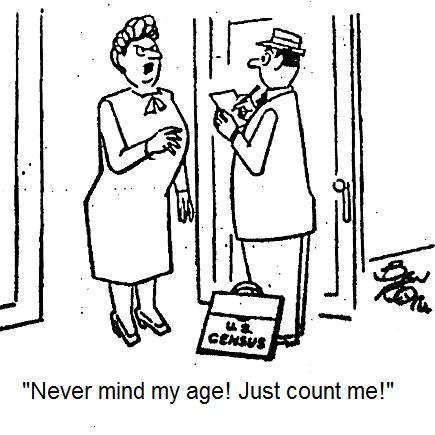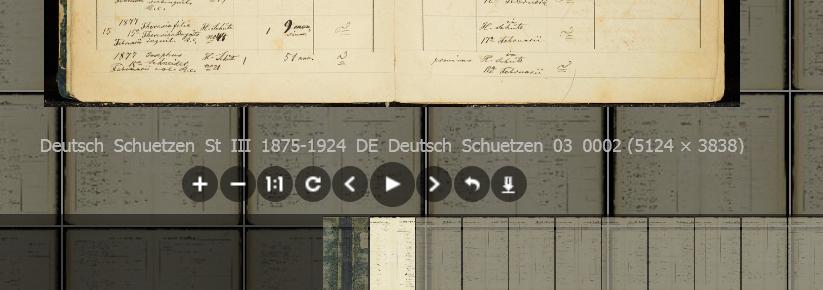|
The
|
||||||||||||||||||||||||||||||||||||||||||
THE BURGENLAND BUNCH NEWS - No. 305 January 31, 2020, © 2020 by The Burgenland Bunch All rights reserved. Permission to copy excerpts granted if credit is provided. Editor: Thomas Steichen (email: tj.steichen@comcast.net) BB Home Page: the-burgenland-bunch.org BB Newsletter Archives: BB Newsletter BB Facebook Page: TheBurgenlandBunchOFFICIAL Our 24th year. The Burgenland Bunch Newsletter is issued monthly online. The BB was founded in 1997 by Gerald Berghold, who died in August 2008. |
||||||||||||||||||||||||||||||||||||||||||
| Current Status Of The BB: * Members: Members: 2915 * Surname Entries: 8907 * Query Board Entries: 5787 * Staff Members: 13 |
||||||||||||||||||||||||||||||||||||||||||
|
||||||||||||||||||||||||||||||||||||||||||
1) THE PRESIDENT'S CORNER (by Tom Steichen)  Notice:
The BB newsletter will no longer offer three "full" articles each month. Notice:
The BB newsletter will no longer offer three "full" articles each month.The above is an announcement that I have been considering for a number of months and have finally decided to make. I have been editor and chief writer of this newsletter for over nine years now, with this being my 105th edition. Having three "full" articles in each edition was an arbitrary choice I made some years ago. Although I am still quite able to write articles, it has become much more difficult to find new topics I consider worth sharing with you. Thus I have decided to stop the monthly hunt for topics (merely to fill the newsletter) and will write only what falls out in the normal course of business, dropping that self-imposed dictate of three full/extended articles. That means there will be months with no full articles... but, if ideas jump out, there may be months with multiple articles with my by-line. I'll also continue to edit and publish whatever articles you members choose to write and make available to this newsletter. This tidbits section will continue, as will the standard sections: Historical Newsletter Articles, Ethnic Events and Emigrant Obituaries. So, there you have it. As for this month's collection of bits and pieces (Article 1), it begins with both good and bad news about the Eisenstadt Diocese church records, talks about the recent Austrian national election and the resulting Burgenland state election, passes along some great tourism news for Burgenland, and then closes with our regular tidbit features, the monthly BB Facebook report, book sales (with some analysis), a recipe and a cartoon. Article 2 is our sole extended/full article this month, being A First Tutorial for Matriken.AT, the Eisenstadt Catholic Diocese's new website for its online church book archives. I say a first tutorial because it is my expectation that Matriken.AT will evolve as it makes its way from the current beta release to a full implementation. If those changes prove big enough (and I hope not), then I'll need to rewrite this tutorial to take account of the changes. The remaining articles are our standard sections: Historical Newsletter Articles, Ethnic Events and Emigrant Obituaries.  Online
Burgenland Catholic Church Books: Probably the most significant thing within the current beta implementation
of the online availability of the Matriken (register books) of the Catholic Diocese of Eisenstadt is the withdrawal
of many of the invasive questions that were in the initial release of the registration form.
I suspect those questions existed because the initial Eisenstadt registration
form was based on the registration form for the Györ Diocese. Györ's records sit behind a pay wall and, therefore, require
much more information from its registrants. Online
Burgenland Catholic Church Books: Probably the most significant thing within the current beta implementation
of the online availability of the Matriken (register books) of the Catholic Diocese of Eisenstadt is the withdrawal
of many of the invasive questions that were in the initial release of the registration form.
I suspect those questions existed because the initial Eisenstadt registration
form was based on the registration form for the Györ Diocese. Györ's records sit behind a pay wall and, therefore, require
much more information from its registrants.But here is the BAD NEWS: Those invasive questions will return! The Diocese announced recently that access to the site will remain free only through March; after that it will go behind a pay wall with fees of 10€ (~$11) for 15 days of access, 20€ (~$22) for 3 months of access, and 50€ (~$55) for one year of access. These are the same fees charged for access to the Györ archives so I assume the access levels will also come with the same maximums on downloadable images: respectively, 15, 50 and 200 images at the three levels. Payments for Györ may be made only via "bank remittance" or "cash via postal order"; no credit cards are accepted. Again, I assume (but do not know for sure) that the same payment methods will apply to the Eisenstadt archives. Austrian National Council Election: Back on September 29th, Austria held elections for its National Council, largely because a scandal rocked Austrian politics, particularly the FPÖ party, which was the minority member in the ruling coalition with the ÖVP. That government was dissolved and a caretaker government installed. On January 7th of this year, with the Federal election and subsequent inter-party negotiations complete, a new ÖVP-Green coalition government was installed. Not surprisingly, the FPÖ was the big loser in the election. A bit of a surprise was that the ÖVP gained seats and the SPÖ lost seats, but the real surprise was the Green party going from no seats in the Council to 20 seats, plus a minority share of power in the new coalition government. This is only the second time in 50 years that the ÖVP has dominated the voting in the National Council elections. In Burgenland too, the ÖVP received the most votes (even though the current Burgenland government is led by the SPÖ (in coalition with the FPÖ). The following table shows the percentage (%) of the vote Austria-wide for the 5 largest parties, as well as the number of Council seats they now hold and the change (chg) in seats from the prior government. The column titled Burgenland breaks out the Federal vote in Burgenland, being noticeably more SPÖ- and less Green-oriented than Austria as a whole. The last column shows the most recent allocation of seats in the Burgenland Landtag. I've added that column so you can see the contrast between party preference in the 2019 Federal election (Fed %) and the number of seats currently held by those parties in the Landtag.
Because of this change in voter preference and the taint on the FPÖ in the current Burgenland SPÖ-FPÖ
coalition government, a new Burgenland election was called for January 26th. However, this text was written before that date
so I do not yet know the official results. Clearly, though, if the Federal results translate to the State election, we may
be seeing a new ÖVP-led coalition state government, but who they join with to get a majority (at least 19 seats)
remains unclear. I'll also note that Lulu is a print-on-demand service, making it particularly
appropriate for "self-published" small-volume books and for small order sizes. Given that, over years 2014 through 2018 (the
Burgenland book was released for public sale in January 2014) there have been over 300,000 books published on Lulu
(and even more if we add in 2019... but 2019 stats have not been released). Still, our Burgenland book ranks as #566,
meaning only 565 books currently on Lulu have sold more copies. That is pretty impressive. It was also #7 this past
month in its "History" category. |
||||||||||||||||||||||||||||||||||||||||||
2) A FIRST TUTORIAL FOR MATRIKEN.AT 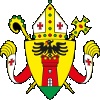 As
you should be aware of by now, the Eisenstadt Catholic Diocese has opened a beta (pilot/test)
version of its website for their vital records books (baptisms/births, marriages, deaths), found here:
https://matriken.at/. This website is free to access but you must first register and
obtain a user name and password. As
you should be aware of by now, the Eisenstadt Catholic Diocese has opened a beta (pilot/test)
version of its website for their vital records books (baptisms/births, marriages, deaths), found here:
https://matriken.at/. This website is free to access but you must first register and
obtain a user name and password.Here is an image of the initial (home) page of the site: 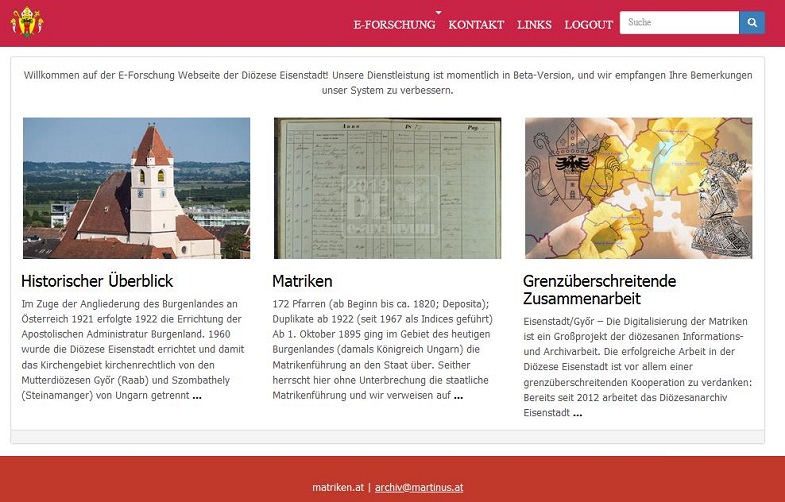 Despite the graphics in the center of the homepage, you will do everything useful via the pull-down menus at the top. Because I was logged in when I captured the above image, menu "LOGOUT" appears. Had I not been logged in, it would have read "LOGIN". The other menu choices remain the same whether you are logging in or not, however, some items in a menu will only appear when you are logged in. The menus are E-FORSCHUNG (= E-research [the menu you will use most]), KONTAKT (= contact), LINKS (= links), and LOGIN/LOGOUT (=login/logout). There is also a SUCHE (= search) box, which I have yet to explore for usefulness. Before I get further into how to use this site, let me say a few cautionary words: 1) This is a pilot (beta) website. Thus it is neither complete nor guaranteed to continue to function as-is. Further, it may not remain free ...simply, I do not know what the intentions are for the production website (and after I first wrote this sentence, the Diocese announced that it will become a pay site). [Note: You will see me say "I do not know" frequently in this tutorial. The Diocese has not given out much information so I can say little with any assurance that what I say will remain true, or that things I think are true really are true. Further, I have already observed changes from when I first registered; and I expect there will be more changes!]. 2) Like you, I'm learning how to use the site; given that, my advice may change as I learn more or if the site changes further as it matures toward its full implementation. 3) As of this writing, it contains records for only 58 (now 60) of the 172 parishes in the Diocese; other parishes should appear as the install progresses but there is no guarantee all parishes will appear (I do not know). Further, there has been no statement concerning whether the installed records for these villages constitute all of the available records for the currently available villages (again, I do not know). 4) There are obviously-intended features that do not yet work (for example, the button for downloading images does nothing at this time). 5) The BB has done nothing yet to provide easier or direct access to the records from the BB site or to provide better interpretations of the current cryptic sub-collection naming-notation. At this writing, I do not even know if easier access is possible or if there is enough consistency in notation to give you a "key" to understanding these names (however, I will make a first attempt in this article on the notation issue). So, let's get started! Clearly, the first step is to register for a login. So, go to https://matriken.at/ and hover your cursor over the E-FORSCHUNG (E-research) menu. The choices will be Registrierung (Registration), Überblick (Overview), Verarbeitung (Processing), Gesetzliche Bestimmungen (Legal Regulations), and AGB und Garantie (Terms and Conditions, and Guarantee). All of these are obvious except for Verarbeitung (Processing), which is the list of parishes that have been processed (i.e., are currently available), and Gesetzliche Bestimmungen (Legal Regulations), which discusses the Austrian privacy laws and the resulting restrictions on access to recent records (more on this below). There will be one change to these choices once you have a login and sign in: the Registrierung (Registration) will be replaced by E-Forschung Start (E-research Start), which is where you will need to go to access records. So, click Registrierung to start the process for obtaining a login. That will take you to a page titled Benutzerkonto (User Account) that has three tabbed choices: Neues Benutzerkonto erstellen (Create a new user account); Anmelden (Register); and Neues Passwort anfordern (Request new password). You'll want the first of these (which should be the default choice). This will display the registration form. I won't show the form here, but will give you translations of the text on it. The original registration form asked for some information that I perceived as inappropriately invasive (however, the worst fields have now been removed and others are no longer required). I put "private" in the required fields that bothered me and the registration process accepted that answer; I suspect you can do that too. So, here is a translation of the (current) form text (in the order it appears on the form), where * means this is a required field, blue backgrounds indicate section header lines, and small, gray text is for information only:
Once you fill out the form and add a tic mark indicating acceptance of the terms and conditions (they are inoffensive),
you click Neues Benutzerkonto erstellen (Create a New User Account) to send in the registration. You will
receive an email asking you to click a link to reset your temporary password with a double-entered new password. The email
and webpage will not be in English but it should be obvious enough that you can proceed without help (I don't want to create
another account to verify the current procedure). |
||||||||||||||||||||||||||||||||||||||||||
3) HISTORICAL BB NEWSLETTER ARTICLES Editor: This is part of our series designed to recycle interesting articles from the BB Newsletters of past years. I go back twenty years this time, to when Gerry wrote about about the Hungarian Reformed (Calvinist) Church... but first I feel compelled to show a few extracts from the article that was directly responsible for my involvement with the BB, as I was the "volunteer still needed!" THE BURGENLAND BUNCH NEWS - No. 72 January 15, 2000 HOMEPAGE SURNAME LIST VOLUNTEER STILL NEEDED [Ed: Members Ralph Nielson and Bob Geshel wrote in with changes to their entries in the Surnames List...] Gerry Berghold replied: Sorry, the Surnames List has been frozen indefinitely since we don't have a volunteer to maintain it. We now have a year's backlog of changes. ... Until such time as we have a volunteer, you can find members who are researching particular family names by searching the Membership List (all 400+ members). Interested volunteers may contact Hap Anderson for details of what's involved. Familiarity with HTML required. ... If no volunteer comes forward, we may eventually delete the Surnames List. [Ed: As I noted above, I was the volunteer who answered this call for help some 20 years ago... by April of 2000, Gerry announced that the Surnames List was "defrosted" and much of the backlog had been worked through. Since then, it has never again been frozen and, although other editors have been in charge of it, it has remained a personal favorite for me!] HUNGARIAN REFORMED CHURCH - OBERWART REGION - by Gerry Berghold 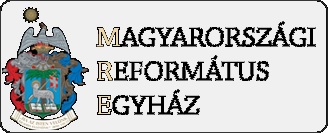 In past
articles we've addressed some of the minority ethnic and religious groups which make up today's Burgenland. Some may find it
painful to read about some of the old animosities, but knowledge of the past provides clues as to the possibility and
location of old records. We firmly support today's ecumenical efforts and have no wish to stir up old conflicts. We also
hope that archives everywhere may become available for research, regardless of religion or ethnicity. One religious group we
haven't covered are the Hungarian Calvinists (Hungarian Reformed Church = Magyarországi Református Egyház) who
were part of the Protestant movement of the Reformation. In past
articles we've addressed some of the minority ethnic and religious groups which make up today's Burgenland. Some may find it
painful to read about some of the old animosities, but knowledge of the past provides clues as to the possibility and
location of old records. We firmly support today's ecumenical efforts and have no wish to stir up old conflicts. We also
hope that archives everywhere may become available for research, regardless of religion or ethnicity. One religious group we
haven't covered are the Hungarian Calvinists (Hungarian Reformed Church = Magyarországi Református Egyház) who
were part of the Protestant movement of the Reformation.Carol Sorenson raises some interesting questions. CAROL WRITES: ...With your latest issue of the BB [newsletter], you have me thinking in a more expansive way when we search our family history. I have always thought of my family as Hungarians living in Burgenland. From my trip this summer, I found my Croatian/Czech/German roots all in the Oberwart district. I immensely enjoy your articles, and I now know how these ethnic groups got to Burgenland, however, is it possible you could address more of the Hungarian (especially the Calvinist / Reformed) presence in Oberwart? Most all of my family there and in the district speak Hungarian as their family language. My family in Oberwart seems to dead-end after 3 generations back from current day relatives... of course the name is spelled various ways, but from "Die Obere Wart" book, I see a Fayth in Unterwart in 1549. Any clue as to where Fajt, Fait, Faijt (as I have seen from church records) came from? (The Hungarian pronunciation is like "fight" in English.) Today it is spelled Faith. I believe the adding of the "h" is a decree for Hungarian families in the area. Am I correct? Happy Holidays! Carol Sorensen ANSWER: Hello Carol. Although I closed the BB office for the holidays, I can't resist reading my mail and, when I find an interesting question, I'm moved to comment. As you probably know, the Burgenland population is composed of about 84% German, 13% Croatian and 3% Hungarian. There is (was), in addition, less than 1% "other" (Hebrew, Roma, Slovene, Slovak, etc.). Unfortunately, being of German extraction, I'm not as versed in the other ethnic and religious groups as I am in German Catholic and Lutheran. We do have some member experts in the other groups, however, so I'll pass your request on in the form of an article in the newsletter. Our Croatian members have been most active; maybe we can stir up some Hungarian members. I'll mention the little I know. Given the small number of Hungarians in the Burgenland, we must again split them into Roman Catholic and Hungarian Reformed, an even smaller group. In the 1500s, the Protestant movement quickly spread through Austria and Hungary; Lutheran in Austria proper and along the Hungarian border (Güssing, Oberwart, Pinkafeld, Kobersdorf, Mattersburg, Gols and Mürbisch am See among others becoming Lutheran centers) and Calvinism (Reformed) in the Hungarian-speaking villages and Hungary proper. With the advent of the Counter Reformation in the 1600s, the pendulum swung the other way and Catholicism returned when the aristocracy reverted to the older faith. There were isolated pockets of Protestants who refused to convert and some had to migrate. Fortunately for them, both the Batthyány and Esterhazy aristocrats were fairly tolerant in matters of religion, and the Burgenland region (both sides of today's border) became a haven for some of these religious refugees. Today's existing Lutheran enclaves, as well as a small presence of Hungarian Reformed, in Austria are the result. There were, however, Hungarians in the "Wart" regions before the Reformation and these too probably switched to the Reformed faith. Some questions arise. Why did Lutheran tenets appeal to German-speakers and Reformed tenets to the Hungarians? Was it a simple matter of language (most Lutheran reformers spoke only German and Latin) or is there a more significant reason? Were Reformed tenets more appealing to the Hungarian (Magyar) desire for independence? Why did the Croatians (for the most part) continue in the Catholic faith during the reformation? Was it because there were no Protestant pastors who spoke Croatian? All of the above has significant meaning to those of us who may have Protestant ancestors in our genealogy. It means we must search the records of both faiths. You will find family attending both churches and there was intermarriage, even though there could be strong ethnic and religious animosity right up to the present day. A quick scan of the 1873 Hungarian Gazetteer pages from LDS microfilm 6000840 [Ed: now available online from our "Gazetteers" page] shows that, in Vas Megye, there were nine Reformed (REF) parishes. They were (numbers refer to the size of the Reformed congregation): In Kormend district: Kormend 707; Nagyrákos 399; Rádócz (Egyházas) 343; Szecsöd (Terestyén) 17. In St. Gotthárd district: Kercza 272; Senyeháza (Zsenyeháza) 264; Szalafo 589; Ori-Szent-Péter 840. In Felso-Eor district: Felso-Or (Oberwart) 1480. Sopron Megye had one: Csepreg district: Nagygeresd 302. Moson Megye had none. Of these villages, only Felso-Or (Oberwart) became part of Burgenland; Kormend had parisheners in villages in subsequent Burgenland territory. The LDS records for the REF villages that remained in Hungary post-1921 start in 1783 (after the Edict of Toleration). This means that the REF records filmed for those villages in today's Burgenland were filmed from the 1828 government copies in Budapest. The earlier records are undoubtedly with the churches in the Burgenland. Even older records may be in Catholic archives which date from when the Protestant churches were converted! It follows that, until these earlier records are copied, the only way to get pre-1828 data is to visit or write the parish. CAROL REPLIES: I didn't expect to see your message... thanks and Merry Christmas! My mother has translated from Hungarian, a booklet about the history of (the) Reformed Church in Oberwart. I need to work on it to get it into workable sentences, but I shall delve into it after the Holidays. Perhaps it will be of some value to you. It goes into how the Reformed congregation had to literally hand over their keys to the Catholic church, and even negotiate in Vienna to allow to continue. There are names of people who were influential ...especially a woman(!) in the very early history. The church had to be rebuilt near the Pinka river (as decreed by Maria Theresa) so that when it flooded it would take the church away ...it still stands. I did not realize what a minority my Hungarian relatives were. |
||||||||||||||||||||||||||||||||||||||||||
4) ETHNIC EVENTS LEHIGH VALLEY, PA Saturday, February 1: Grundsau-Wache at the Lancaster Liederkranz. Info: www.lancasterliederkranz.com Sunday, February 2, 7 am: Grundsau Dag (PA German Groundhog Day Celebration) at Wehr's Dam Park in South Whitehall Township. Sponsored by Grundsau Lodsch Nu. 16 am Jahden. Info: (610) 395-4282 or www.pressreader.com/usa/the-morning-call/20200130/282437056101049 Saturday, February 8: Fasching at the Lancaster Liederkranz. Music by The Continentals. Info: www.lancasterliederkranz.com Sunday, February 9: St. Valentine's Day Dance at the Coplay Sängerbund. Music by the Josef Kroboth Orchestra. Info: www.coplaysaengerbund.com Saturday, February 15: Fasching at the Evergreen Heimatbund in Fleetwood. Music by Maria & John. Info: www.evergreenclub.org Sunday, February 16: Lumpenball at the Coplay Sängerbund. Music by the Emil Schanta Band. Info: www.coplaysaengerbund.com Saturday, February 22: Lumpenball at the Lancaster Liederkranz. Music by Die Mädeljäger. Info: www.lancasterliederkranz.com Sunday, February 23: Sunday Dance at the Coplay Sängerbund. Music by The Polkateers. Info: www.coplaysaengerbund.com NEW BRITAIN, CT Friday, Feb 7, 7 pm: Heimat Abend. Austrian Donau Club, 545 Arch Street, $3. Music by Frank Billowitz. Friday, Feb 21, 7:30 pm: Heurigan Abend. Austrian Donau Club, 545 Arch Street, $3. Music by Schachtelgebirger Musikanten. ST. LOUIS, MO (none) UPPER MIDWEST (none) |
||||||||||||||||||||||||||||||||||||||||||
5) BURGENLAND EMIGRANT OBITUARIES ...none this month |
||||||||||||||||||||||||||||||||||||||||||
| END OF NEWSLETTER (Even good things must end!) |
||||||||||||||||||||||||||||||||||||||||||
|
Burgenland Bunch Newsletter, copyright © 2020 by The Burgenland Bunch |
||||||||||||||||||||||||||||||||||||||||||
 News
News
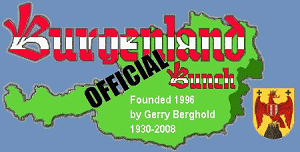 The
Facebook Bunch (from Vanessa Sandhu):
The
Facebook Bunch (from Vanessa Sandhu):  Update
for book "The Burgenländer Emigration to America": Here is this month's update on purchases of the English issue of
the 3rd edition of Dr. Walter Dujmovits' book "Die Amerika-Wanderung Der Burgenländer."
Update
for book "The Burgenländer Emigration to America": Here is this month's update on purchases of the English issue of
the 3rd edition of Dr. Walter Dujmovits' book "Die Amerika-Wanderung Der Burgenländer."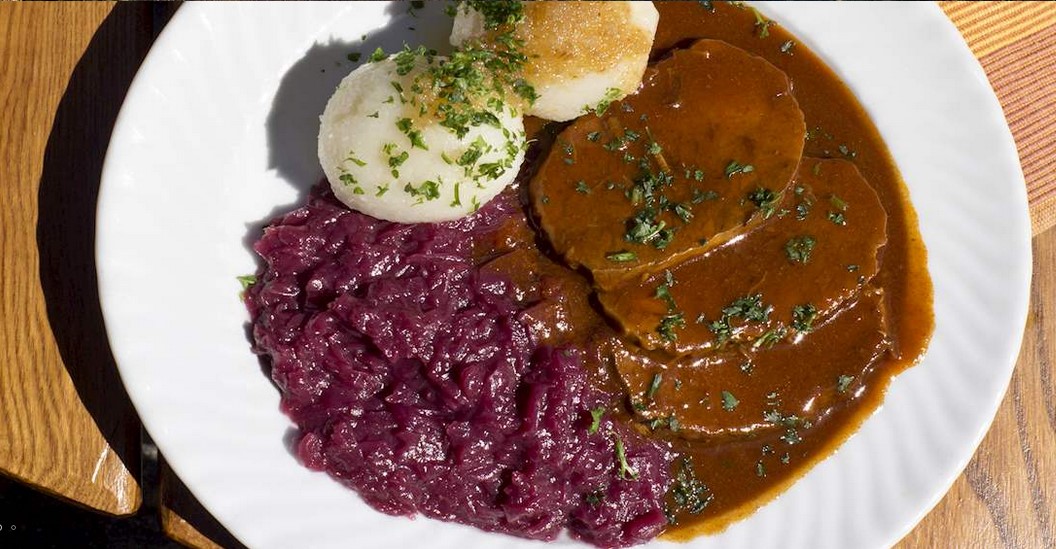 Trudy's
Sauerbraten
Trudy's
Sauerbraten
